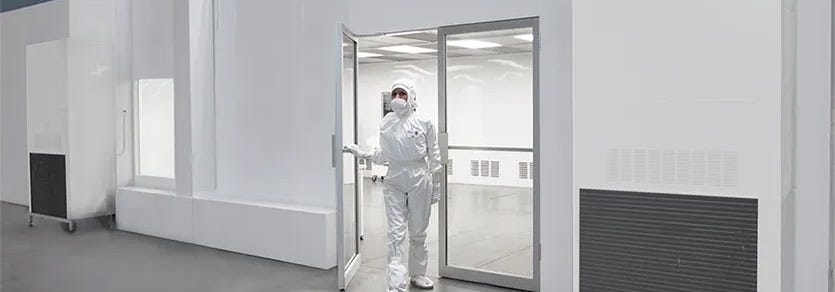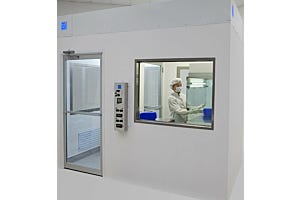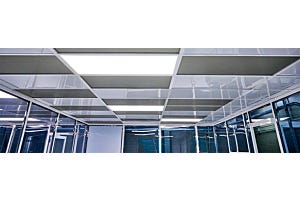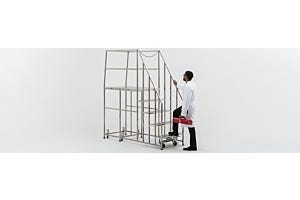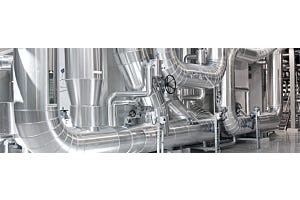The difference between isolation and containment typically identifies the type of airflow design within the environment. In practice, a cleanroom may require both positive and negative pressure systems within a single cleanroom suite.
- An isolation cleanroom is a positive pressure room appropriate for ultra-clean processes, aseptic workflows, pharmaceutical compounding, and biologically sensitive applications.
- A containment cleanroom is a negative or neutral pressure room that typically exhausts contaminated air to an outside area to prevent operational exposure to toxic, potent, or noxious substances.
What is a Containment Room?
Negative pressure cleanrooms prevent chemical fumes and aerosols from escaping a designated area containing bioaerosols, fine particulates, allergens, and other airborne contamination. A ducted exhaust vent continually evacuates fumes, particulate, and other air contaminants. Contaminated air is removed by an externally vented exhaust or recycled and filtered via carbon scrubber, HEPA filtration system, or both before recirculating. Dirty air is either routed to an outside environment, or passed on for further downstream treatment which may include UVC decontamination, HEPA filtration, or carbon-activated scrubbers.
Negative Pressure Room Air Changes
A containment room or containment cleanroom often describes a closed-loop environment that filters and evacuates toxic chemicals, fumes, particulates, and bio-aerosols. Reverse flow fan filter units or fume hoods continually evacuate contaminated air from the room. Air change rates (ACR) typically fall between 12 - 30 ACH. The air supply system is carefully calibrated to maintain negative pressure, which prevents contaminated air from escaping the containment.
In containment applications, the air delivery system operates under continuous negative pressure. Negative pressure cleanrooms maintain a lower pressure than the surrounding environment, which is entered through a positive pressure anteroom. Within a negative pressure room, a negative pressure fume containment hood or bio-safety workstation provides direct exhaust from surfaces where products are prepared and stored. Air is continually flushed through the room, and evacuated by a dedicated exhaust handling system or routed directly to an outdoor environment. In some cases, downstream UV eradication, molecular filters (carbon scrubbers) and/or particulate (HEPA) filters are able to safely decontaminate and recycle air to an internal environment.
What is an Isolation Room?
For cleanroom enclosures, positive pressure is required when isolating a product or person from airborne pathogens, cross-contamination, particulate, and opportunistic spores or microbes.
Positive pressure cleanrooms, also referred to as isolation rooms, “isolate” the contents of the room by maintaining a higher air pressure than surrounding areas. Because air flows from high pressure to low pressure, the pressure differential allows clean air to escape but no dirty air outside to enter.
Softwall vs Hardwall Isolation Rooms
An isolation room is configurable as a dedicated structure with hard walls, or with softwall curtains. Softwall structures provide relatively little pressure containment, however, are generally effective for maintaining some degree of structural barrier between clean and dirty areas. Hardwall cleanrooms are the most common option for maintaining consistent and stable room pressure. Hardwall isolation cleanrooms are configurable with integrated air showers and airlocks, an additional benefit for maintaining pressure gradients and preventing contamination from entering the clean area.
Isolation Rooms for COVID-19 and Infectious Diseases
Virtually all cleanroom, healthcare, and laboratory applications require HEPA filtered air sources that scrub the air of buoyant particles, allergens, or microbes. Increased airflow velocity and unidirectional air patterns improve the rate and consistency of air exchange, which also curbs the ability of viable and non-viable pathogens to remain airborne.
For those with strong and healthy immune systems, encountering germs and pathogens is routine. For people with compromised or weakened immune systems, it's more challenging to overcome and recover quickly from mild illnesses or infections. At-risk categories often include those recovering from burns, chemotherapy patients, postoperative recovery, and those with immune response disorders.
Adopting New Methods of Air Quality Control and Infectious Disease Control in Hospitals and Patient Care
Novel diseases create extremely challenging scenarios for hospitals. Most hospitals lack biological containment wards capable of hosting large numbers of patients in parallel. Alongside the typical functions of a hospital such as emergency rooms, outpatient areas, and general practice. Not only does the hospital need to adapt to increasing volumes of patients with COVID-19, but it also needs to provide additional engineering controls to prevent widespread exposure and infection of staff and patients.
Biocontainment wards, pharmaceutical cleanrooms, and hospitals overcome some of these challenges by constructing separate triage areas and improving overall air quality via portable HEPA filtration.
Modular negative pressure rooms are ideal for rapidly creating a pressure-controlled environment within a pre-existing space. Negative-pressure containment cleanrooms include exhaust plenums that route air to floor or ceiling-mount air returns, and prevent hazardous aerosols or materials from exfiltrating to nearby spaces or corridors.
For hospitals and healthcare facilities where new construction is not feasible, Terra's reverse flow fan filter units convert any into a negative pressure space by porting room air to an outside environment.
View: Negative Pressure Isolation Room Cleanroom Construction
Combined Isolation and Containment Systems
Pharmaceutical facilities and hazardous environments often have more strict nomenclature when referring to isolation barriers or hazardous containment systems. Adding to the confusion, some systems may require both isolation and containment structures. A facility compounding non-sterile, non-hazardous drugs, as well as hazardous drugs or material in unison, will require separate partitions to support both positive and negative pressure areas.
For example, some cancer therapies may require sterile environments during the manufacturing and packaging of a drug. Simultaneously, protective measures must be in place to prevent exposure to drugs known to be toxic, cause cancer, or increase the risk of birth defects. Facility design must be carefully designed with a controlled flow of air between parallel rooms.
Pharmaceutical Isolation Barriers and Containment Systems
Pharmaceutical manufacturers hold a unique definition for isolation structures, which describes a system that reduces the likeliness of product contamination. Containment systems describe methodologies and tactics to prevent operational exposure to toxic, potent, or noxious substances.
A pharmaceutical compounding suite for hazardous drugs requires numerous engineering controls, most of which are defined by USP chapter <800>. Controlled access points, airlocks, and cascading pressure design allow acute control of air pressure differentials between shared walls.
Pharmaceutical environments are often small in terms of square footage; the larger the floorplan, the more time and labor it requires for cleaning. Cascading pressure allows for the most critical rooms in a cleanroom suite to maintain a higher pressure than parallel rooms.
Positive pressure pharmaceutical rooms are often required in tandem with negative pressure containment rooms. Injectables and IV bags may require positive pressure systems appropriate for maintaining sterile environments free of mold, particulates, and bio-burdens. The same pharmacy may also require the handling of hazardous substances such as chemotherapy remedies or radioactive medicines. In this case, a Biosafe cleanroom allows the construction of a structure with a small footprint that can also provide adequate air changes and exhaust filtration for USP-rated environments.
Need Help Retrofitting or Constructing a Negative Pressure Environment?
Terra is a leader in developing isolation and containment structures for nearly any environment or application. Terra specialists provide comprehensive support at every stage of the construction and outfitting process.
Terra's product lineup provides a wide selection of cleanroom containment enclosures and components and filtration systems. Softwall enclosures and portable HEPA filtration are cost-effective and affordable, but also have the benefit of in-stock selection and factory-direct delivery. For larger outfittings and hardware enclosures, Terra provides end-to-end engineering, consulting, and construction services. Each system is carefully planned to meet and exceed expectations for the application, as well as any state, federal, or local requirements for fire and safety.
Terra manufactures products at our main campus in Fullerton, California. Most products are stocked and available for immediate shipment. For project-specific pricing and lead times, contact your Terra Universal product sales specialist for a same-day quote.
Browse Cleanrooms and Filtration Equipment at Terra Universal



